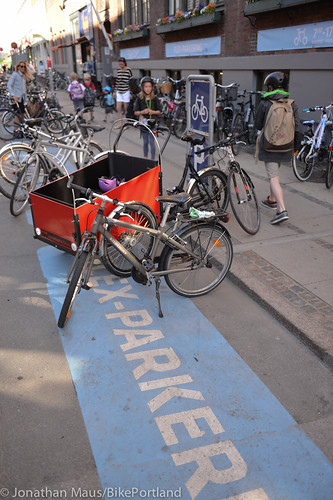
only for part of the day.
(Photos © J. Maus/BikePortland)
This post is part of ongoing coverage from Europe. Read more stories from my trip here.
You might have a perception that everyone bikes in Copenhagen, or that the City has carte blanche to put cycle tracks and bike parking wherever they please. It turns out that’s not exactly true.
Copenhagen has some of the same problems we do: Such as finding space for bikes when cars need space too. As the number of people who bike goes up, so does competition for road space. And there are still many people in Copenhagen (a growing number actually) who prefer to drive. A few days ago I met Niels Hoe, a consultant who formerly managed the City of Copenhagen’s bicycle parking program. Hoe shared an interesting concept called “flex parking”.
At issue was an extreme lack of bicycle parking space at Ingrid Jespersen High School in the Østerbro district. Directly in front of the school are five auto parking spaces. With dozens and dozens of families that ride to the school each day, there wasn’t enough bike parking to go around. As a result, bikes were everywhere and the sidewalk was a cluttered mess. This is where Hoe comes in. He fashions himself as an expert on the “dynamic use of road space”. That is, he has lots of experience fitting bicycles into a constrained urban environment (he’s currently on contract with the City to map locations for their bike share stations coming this fall). “It’s a school so it needs a lot of bicycle space during certain hours,” Hoe explained, “but after school hours cars need the space.”
The solution Hoe helped devise was to make the space work for cars and bikes. Between the hours of 7:00 am and 5:00 pm on weekdays the space is for bicycles only. Cars can park in the spaces during all other hours and on the weekends. To make the spaces work, the City added blue pavement markings, and signage on the sidewalk and on banners that hang on the wall of the school that faces the street (both are very inexpensive). Police enforcement has also been a part of this project. They issue fines for people who park cars in the space during school hours. On the bike side of things, it’s the school’s responsibility to make sure there are no bikes left after 5:00 pm. (If there are, they can simply pick them up and put them on the sidewalk.)
This is a classic compromise, says Hoe, because people who bike don’t get the benefit of an actual rack (you need a kickstand to use it), and people who drive are only allowed to use the space for limited hours. “Bikes get an 80% solution; but it’s also not ideal for cars,” is how he puts it.
I visited the site on Friday morning and saw a bustling scene. Bikes lined the racks that are attached to the school wall adjacent to the sidewalk and the flex parking area was nearly full. I couldn’t imagine how crowded the sidewalk must have been before this was put in place.
Thomas Westergaard-Kabelmann, who has a 1st grader at the school, told me that, “It was chaos” before the flex parking. It was especially difficult, he said, to park cargo bikes like his. He seemed really pleased with the solution. He also shared that this is part of a “gradual cultural shift” that has been going on in Copenhagen for the past 5-10 years as people begin to embrace bicycling and realize its popularity demands changes in how public space is designed.
Hoe says the City tried this as an experiment (they do that a lot) two years ago and it has worked so well the concept has been expanded to four other schools. You can learn more about Hoe’s work on flex parking and his many other innovative ideas on his website. He will also be a presenter at the upcoming Velo City conference in Vienna later this month.
— Read more of our coverage from Copenhagen here.










